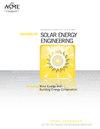圆形和三角形管粗糙化逆流太阳能空气加热器的数值研究
IF 1.9
4区 工程技术
Q3 ENERGY & FUELS
Journal of Solar Energy Engineering-transactions of The Asme
Pub Date : 2023-08-14
DOI:10.1115/1.4063184
引用次数: 0
摘要
粗糙度几何结构已被引入以提高太阳能空气加热器管道中的传热率。在目前的工作中,圆形和三角形几何形状被用作矩形通道中的粗糙度元素,以提高逆流太阳能空气加热器(RFSAH)的热性能。为研究选择的重要参数是雷诺数(Re)在5000到18000之间变化(5个值),节距比(P/e)在4到12之间变化(五个值)和高度比(e/D)在0.0392到0.1571之间变化(4个值)。使用ANSYS(Fluent 2022R1)开发了二维CFD模型,并使用k-ε(RNG)湍流模型进行了模拟,并用一组光滑管道和先前研究的实验结果进行了验证。研究结果表明,与雷诺数为12000的光滑通道相比,圆形和三角形粗糙度几何形状的最高传热值分别增加了约2.18倍和2.35倍。当Re为12000时,圆形和三角形粗糙度几何形状的节距比分别为6和5时,热工水力性能因子(TPF)分别为1.58和1.7。本文章由计算机程序翻译,如有差异,请以英文原文为准。
Numerical investigation of reversed flow solar air heater roughened with circular and triangular shaped tubes
The roughness geometry has been introduced to improve the rate of heat transfer in a solar air heater duct. In the current work, circular and triangular shape geometries are used as roughness elements in the rectangular channel to enhance the thermal performance of reversed flow solar air heater (RFSAH). The important parameters selected for the research are Reynolds number (Re) varies from 5000 to 18000 (5 values), pitch ratio (P/e) varies from 4 to 12 (5 values), and height ratio (e/D) from 0.0392 to 0.1571 (4 values). A 2D CFD model was developed using ANSYS (Fluent 2022R1), and simulation was performed using k-ε (RNG) turbulence model and validated with one set of experimental results for smooth duct and previous research. The findings revealed that the highest value of heat transfer was augmented about 2.18 times and 2.35 times for circular and triangular roughness geometry respectively, as compared to the smooth channel at a Reynolds number of 12000. The thermohydraulic performance factor (TPF) is 1.58 and 1.7 at pitch ratios of 6 and 5 for circular and triangular roughness geometry respectively, at Re of 12000.
求助全文
通过发布文献求助,成功后即可免费获取论文全文。
去求助
来源期刊
CiteScore
5.00
自引率
26.10%
发文量
98
审稿时长
6.0 months
期刊介绍:
The Journal of Solar Energy Engineering - Including Wind Energy and Building Energy Conservation - publishes research papers that contain original work of permanent interest in all areas of solar energy and energy conservation, as well as discussions of policy and regulatory issues that affect renewable energy technologies and their implementation. Papers that do not include original work, but nonetheless present quality analysis or incremental improvements to past work may be published as Technical Briefs. Review papers are accepted but should be discussed with the Editor prior to submission. The Journal also publishes a section called Solar Scenery that features photographs or graphical displays of significant new installations or research facilities.

 求助内容:
求助内容: 应助结果提醒方式:
应助结果提醒方式:


